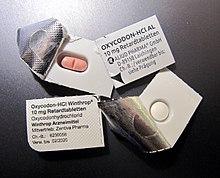Narcotics

The term narcotics (BtM) comes from the beginning of the 20th century. At the time, it was used to denote the substances used to numb severe pain and classified as medicinal products such as opium , morphine and cocaine . After the Second World War , the legal and medical meanings of the term narcotics diverged from each other in Germany and Switzerland due to the narcotics equality ordinances. In Austria the internationally accepted term Narcotic Drug contrast with narcotic respectively Substance translated.
Germany
In the German Narcotics Act (BtMG), all substances or preparations that are listed in Annexes I to III to Section 1 (1) BtMG are referred to as narcotics. Cultivation, manufacture, trade, import, export, sale, sale, placing on the market and acquisition, for which a permit according to § 3 BtMG is necessary, are regulated in this law.
Medicine prefers to use the term anesthetic . This refers to drugs that are used to create anesthesia (state of numbness - whether local or general). In some cases, the legal term and the medical term overlap: (Example: cocaine , including a local anesthetic , is subject to narcotics regulations), lidocaine, for example, also has a local anesthetic effect, but is not subject to any narcotics regulations, since - in contrast to the substance cocaine - there is no significant potential for abuse - for example as a high drug - possesses. Likewise, opioids are largely subject to the Narcotics Act, as they - in addition to a high potential for abuse as a drug, due to its (depending on the substance and type of application more or less) strong psychotropic effect - also have a high dependency potential that should by no means be underestimated. As a rule, non-opioid analgesics are not subject to any narcotics regulations ( ibuprofen , acetylsalicylic acid , paracetamol ), as they have little or no psychotropic effect and therefore no significant abuse for intoxicating purposes is possible (with a few exceptions such as ketamine ). Another example of BtM are methadone preparations, which are used in drug replacement therapy and are manufactured in pharmacies as prescription drugs . Substances such as amphetamines , which do not have an anesthetic effect but, on the contrary, have a strong stimulating effect, are BtM in the sense of the law.
construction
The substances that fall under the Narcotics Act in Germany are divided into three systems:
| Systems according to BtMG | Status in Germany | Examples |
|---|---|---|
| Appendix I. | Non-prescription and non-marketable narcotics | LSD , heroin (unless prescribed by a diamorphine release program) |
| Appendix II | Non-prescribable but marketable narcotics | Poppy straw concentrate |
| Annex III | Prescription and marketable narcotics | Morphine , fentanyl |
Appendix I of the BtMG lists substances that can be used to change the state of consciousness such as B. PCP , MDMA (Ecstasy ), psilocybin and others, even if no psychological or physical dependence is possible (e.g. LSD , Salvinorin A ). These narcotics listed under Appendix I are neither marketable nor prescribable. This means that they may not be prescribed for dispensing to patients on prescription, nor may they be traded in domestic trade between participants in the drug trade. The transport and use, for example for research purposes, can be permitted by the BfArM with a special permit. Until the amendment to the BtMVV on March 10, 2017 , cannabis for medical purposes could only be given to authorized patients in Germany with a special permit. In this case, the dispensing was not based on a narcotics prescription, but by means of a dispensing document procedure in accordance with the domestic narcotics trade regulation .
The narcotics listed in Appendix II are marketable, but not prescribable and are treated in a similar way to the substances in Appendix I. These substances are mostly synthetic intermediates for other narcotics, for example those listed in Appendix III.
The narcotics listed in Appendix III, however, are used therapeutically in medicine (e.g. methylphenidate , oxycodone , morphine ) and must then be prescribed by doctors with a special narcotic prescription. The substances in this group are referred to as marketable and prescription narcotics. Some of the substances listed in Appendix III (such as codeine , dihydrocodeine , tilidine and some of the tranquilizers from the group of benzodiazepines used in medicine ) are exempt from the narcotics prescription ordinance and may be prescribed on a customary, "normal" prescription if the preparations meet certain specified requirements that restrict abuse or make it less attractive. These preparations then only require a prescription.
In addition, trips abroad with prescription narcotics according to the Schengen Agreement require certificates from the prescribing doctor (sample from the BOPST at the BfArM ), which must be confirmed by the health department.
